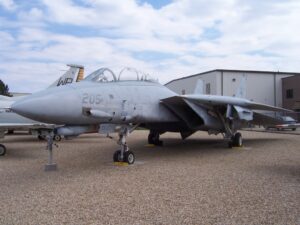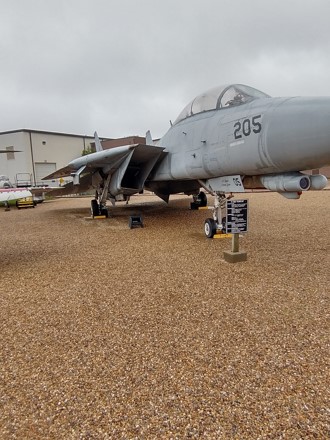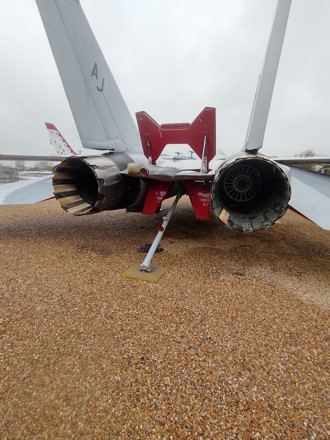Aircraft’s Background
Prairie Aviation Museum received F-14D Tomcat BuNu 161163 in April of 2006 from the US Navy. The final flight of this aircraft was to the Bloomington/Normal airport.
Bloomington/Normal airport.
People came from many states to witness the arrival of aircraft 205 from the VF-213 Black Lions. It would be the last time most would see an F-14 in flight.
This aircraft, F-14D TOMCAT, on loan courtesy of:
the National Naval Aviation Museum at Pensacola, Florida.
BUREAU/SERIAL # 161163 NNAM ACCESSION # 2006.040.001
Interactive Display
Click on a colored PIN to display additional information (text, video, recording, images).
This feature is an extra benefit as you walk around the display in our Airpark.
WIFI is provided for your mobile device. A network QR code or name/password is provided at the desk.















Videos of Interest
This link displays a WIKIPEDIA video of an F-14 Demo flight Run Time (0:05:25)
- Video #1: F-14A TOMCAT 1980s U.S. NAVY FIGHTER AIRCRAFT VS. SOVIET AIRCRAFT Run Time (0:10:30)
- Video #2: F-14 Walk Around by Former Navy Top Gun Pilot Grant Begley Run Time (0:32:00) (Great stories)
- Video #3: F-14 Design Evolution Run Time (0:58:30) (Techies Oasis)
- Video #4: MORE F-14 Tomcat | Behind the Wings Run Time (0:34:59)
- Video #5: F14 Maneuvers Run Time 4:47. Note: at 4:20, 204 from the Black Lions is launched. Our F14 is Black Lions 205.
History
The Grumman F-14 Tomcat is a supersonic, twin-engine, two-seat, variable geometry wing aircraft. During its active service in the United States Navy (1972-2006) the F-14 Tomcat was the Navy’s primary air superiority fighter and tactical reconnaissance platform. It later performed precision bombing in close air support roles. It was developed after the collapse of the F-111B project, and was the first of the American teen-series fighters which were designed incorporating the experience of air combat in Vietnam against Migs.
It entered service in 1972 with the Navy, replacing the F-4 Phantom II. It was later exported to the Imperial Iranian Air Force in 1976. It was retired from the U.S. Navy fleet on 22 September 2006, having been replaced by the F/A-18E/F Super Hornet. As of 2006, only the Islamic Republic of Iran Air Force still flies the aircraft.
The F-14 has completed its decommissioning from the U.S. Navy. It was slated to remain in service through at least 2008, but all F-14A and F-14B airframes have already been retired, and the last two squadrons, the VF-31 Tomcatters and the VF-213 Black Lions, both flying the “D” models, arrived for their last fly-in at Naval Air Station Oceana on March 10, 2006. YouTube Run Time (0:05:14)
The last F-14 combat mission was completed on February 8, 2006, when a pair of Tomcats landed aboard the USS Theodore Roosevelt after one dropped a bomb in Iraq. The plane was part of VF-31 and the last pilot credited with a bomb drop in combat was Lt. Bill Frank. An F-14D from VF-213, the aircraft originally slated to come to Prairie Aviation Museum, was the last F-14 to land on an aircraft carrier after a combat mission; it was piloted by Capt. William G. Sizemore. During their final deployment with the USS Theodore Roosevelt, VF-31 and VF-213 collectively completed 1,163 combat sorties totaling 6,876 flight hours, and dropped 9,500 pounds of ordnance during reconnaissance, surveillance, and close air support missions in support of Operation Iraqi Freedom. On March 10, 2006, the 22 planes from these squadrons flew in formation into Naval Air Station Oceana, home from the last combat deployment of the F-14. VF-213 pilots and radar interception officers who have made the transition to the Super Hornet continued F/A-18F (double seat) training as of April 2006. The squadron is operational, or “safe for flight,” as of September 2006. VF-31 pilots who were making the transition began F/A-18E (single seat) training in October 2006. VF-31 will be safe for flight in April 2007, making it the last official Tomcat squadron in the Navy.
The last flight of the F-14 Tomcat in US service took place October 4, 2006, with the final flight retirement ceremony on September 21, 2006. Two F-14’s were readied for the ceremonial final flight; after the primary plane experiencing mechanical problems, a backup was flown instead. The failure was a reminder of one of the reasons for the retirement, high maintenance costs. The F-14 Tomcat was officially retired on September 22, 2006 at Naval Air Station Oceana. The F-14 fleet is mothballed at the Davis-Monthan “Boneyard.”
General characteristics
- Crew: 2 (Pilot and Radar Intercept Officer)
- Length: 61 ft 9 in (18.6 m)
- Wingspan: 64 ft unswept, 38 ft swept (19 m / 11.4 m)
- Height: 16 ft (4.8 m)
- Wing area: 565 ft² (54.5 m²)
- Airfoil: NACA 64A209.65 mod root, 64A208.91 mod tip
- Empty weight: 42,000 lb (19,000 kg)
- Loaded weight: 61,000 lb (28,000 kg)
- Max takeoff weight: 72,900 lb (32,805 kg)
- Powerplant: 2× General Electric F110-GE-400 afterburning turbofans, 13,810 lbf dry, 27,800 lbf with afterburner (72 kN / 126 kN) each
Performance
- Maximum speed: Mach 2.34, 1,544 mph at high altitude (2,485 km/h)
- Range: 576 mi combat (927 km)
- Service ceiling: 50,000+ ft (16,000+ m)
- Rate of climb: 45,000+ ft/min (230+ m/s)
- Wing loading: 113.4 lb/ft² (553.9 kg/m²)
- Thrust/weight: 0.91
Armament
13,000 lb (5,900 kg) of ordnance including:
- Guns: 1× M61 Vulcan 20 mm Gatling Gun
- Missiles: AIM-54 Phoenix, AIM-7 Sparrow and AIM-9 Sidewinder air-to-air
- Loading configurations:
- 2× AIM-9 + 6× AIM-54
- 2× AIM-9 + 2× AIM-54 + 3× AIM-7
- 2× AIM-9 + 4× AIM-54 + 2× AIM-7
- 2× AIM-9 + 6× AIM-7
- 4× AIM-9 + 4× AIM-54
- 4× AIM-9 + 4× AIM-7
- Bombs: GBU-10, GBU-12, GBU-16, GBU-24, GBU-24E Paveway I/II/III LGB, GBU-31, GBU-38 JDAM, Mk-20 Rockeye II, Mk-82, Mk-83 and Mk-84 series iron bombs
Avionics
- Hughes AN/APG-71 radar
- AN/ASN-130 INS, IRST, TCS
Unit cost
- Unit Cost: US $38 million
| F-14D Tomcat Bureau Number :161163 Total Hours Flown: 7107.4 |  |
| Jan 1981: | This aircraft was inducted into the United States Navy as an F-14A |
| April 1981: | Fighter squadron 143 (VF-143), Pukin Dogs, had custody of aircraft |
| Sept 1982: | Fighter squadron 11 (VF-11), The Red Rippers, had custody of the aircraft |
| Dec 1984: | Fighter squadron 101 (VF-101), Grim Reapers, had custody of the aircraft |
| April 1987: | Aircraft was transferred to a Naval Training Command |
| May 1988: | Fighter squadron 101 (VF-101), Grim Reapers, retained custody of aircraft |
| Sept 1991: | Depot Level Conversion from F14A to F-14D |
| Sept 1992: | Aircraft was transferred to SDLM (Depot Level Maintenance) |
| May 1993: | Fighter squadron 2 (VF-2), Bounty Hunters, had custody of aircraft |
| Feb 1997: | Fighter squadron 31 (VF-31), Tomcatters, had custody of aircraft |
| Sept 1997: | Fighter squadron 101 (VF-101), Grim Reapers, retained custody of aircraft |
| Oct 2000: | Fighter squadron 213 (VF-213), Black Lions, had custody of aircraft |
| April 2006: | Aircraft decommissioned and transferred to Prairie Aviation Museum, Bloomington, IL. |
